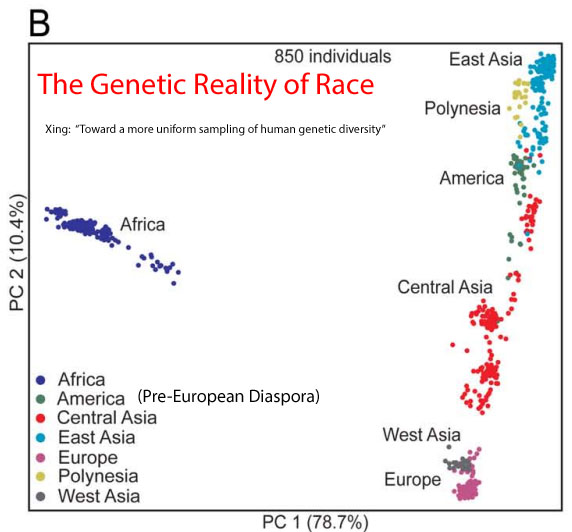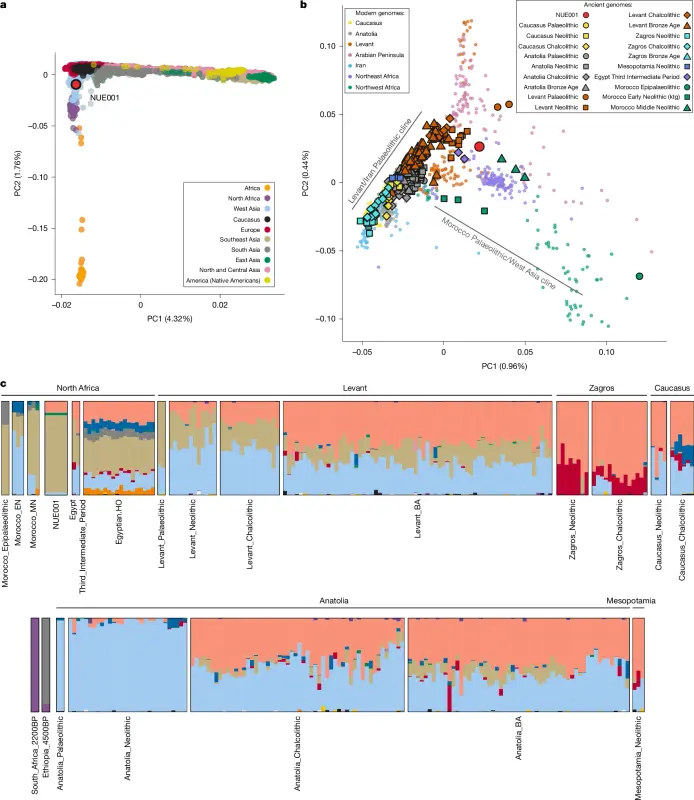一个古埃及人的全基因分析出来了--和中国人没关系
版主: Softfist
#1 一个古埃及人的全基因分析出来了--和中国人没关系
Ancient 'Old Kingdom' Egyptian Genome Reveals Ancestry, Interactions in Region
Jul 02, 2025 | staff reporter
Save for later
Egyptian tombs at Nuwayrat
Rock-cut tombs at Nuwayrat enclosing the pottery vessel containing the pottery coffin burial. Credit: Morez, A. (2025). Nature.
NEW YORK – An ancient genome sequencing study led by investigators in the UK has offered a glimpse at the ancestry patterns present in Egypt some 4,500 to nearly 4,900 years ago, during the transition from an Early Dynastic to an Old Kingdom period when civilizations in the region achieved societal and structural advances such as the construction of Egypt's first pyramids.
"This is actually the most complete genome we have from ancient Egypt, as well as the oldest," first and co-corresponding author Adeline Morez Jacobs, a visiting researcher fellow at Liverpool John Moores University, who previously held a postdoctoral researcher position at the Francis Crick Institute, said during a press briefing with reporters on Tuesday, noting past attempts to generate genetic data on three ancient Egyptians produced incomplete nuclear genome data.
For their study, published in Nature on Wednesday, Morez Jacobs and colleagues from the UK, Sweden, France, and Italy set out to perform whole-genome sequencing on an adult male whose remains were dated to 2570 to 2855 BCE, using DNA extracted from tooth material in remains excavated from the central Egypt Nuwayrat necropolis site, approximately 165 miles south of Cairo.
"We could directly radiocarbon date the remains of this individual, and the dates are consistent with material culture at the site," Morez Jacobs said, adding that the new genome "allows us, for the first time, to get insights into the genetic ancestry of an ancient Egyptian individual from the Old Kingdom period."
The available data placed the Old Kingdom ancient individual in the Third and Fourth Dynasties, after northern and southern parts of the region unified politically. While research going back to the early 2000s suggests that Egyptian populations may not have mixed extensively with outside groups during this time frame, burgeoning trade routes and shifting political dynamics have been described in more recent studies.
Along with published array or genome sequence data for more than 3,200 modern-day individuals and another 805 ancient individuals from various parts of the world, the new genome sequence data suggested that around 80 percent of the Nuwayrat individual's ancestry came from local populations and resembled Neolithic groups originating in North Africa.
The remaining 20 percent of the sequences shared ancestry with groups from Mesopotamia and other parts of the eastern Fertile Crescent, consistent with past archaeological work describing the movement of goods, animal domestication, farming practices, ideas, and cultural advances between Egypt and the Fertile Crescent.
"We have to caveat that with this only being a single individual," co-senior and co-corresponding author Pontus Skoglund, ancient genomics group leader at Francis Crick Institute, told reporters, noting that the Nuwayrat individual's ancestry corresponded with North Africa and a yet-to-be-tested ancient population from the eastern Fertile Crescent.
When the investigators incorporated genetic data for present-day populations in Egypt, meanwhile, they detected additional ancestry from East and West Africa that appeared to have been introduced to the region more recently.
Complementary analyses on the individual's broader skeletal features indicated that the ancient man experienced musculoskeletal stress linked to physical labor, arthritis, and age-related afflictions, the authors explained. Even so, his body was found in a somewhat high-status burial setting, within a pottery vessel stored in a rock-cut tomb that is suspected of helping preserve his genetic material over thousands of years under relatively stable environmental conditions.
More broadly, the authors suggested that the current findings "demonstrate the feasibility of ancient genome sequencing from the earliest stages of the Egyptian Dynastic civilization."
"Future whole-genome sequencing of DNA from more individuals will allow for a more detailed and nuanced understanding of ancient Egyptian civilizations and its inhabitants," the authors concluded.
Jul 02, 2025 | staff reporter
Save for later
Egyptian tombs at Nuwayrat
Rock-cut tombs at Nuwayrat enclosing the pottery vessel containing the pottery coffin burial. Credit: Morez, A. (2025). Nature.
NEW YORK – An ancient genome sequencing study led by investigators in the UK has offered a glimpse at the ancestry patterns present in Egypt some 4,500 to nearly 4,900 years ago, during the transition from an Early Dynastic to an Old Kingdom period when civilizations in the region achieved societal and structural advances such as the construction of Egypt's first pyramids.
"This is actually the most complete genome we have from ancient Egypt, as well as the oldest," first and co-corresponding author Adeline Morez Jacobs, a visiting researcher fellow at Liverpool John Moores University, who previously held a postdoctoral researcher position at the Francis Crick Institute, said during a press briefing with reporters on Tuesday, noting past attempts to generate genetic data on three ancient Egyptians produced incomplete nuclear genome data.
For their study, published in Nature on Wednesday, Morez Jacobs and colleagues from the UK, Sweden, France, and Italy set out to perform whole-genome sequencing on an adult male whose remains were dated to 2570 to 2855 BCE, using DNA extracted from tooth material in remains excavated from the central Egypt Nuwayrat necropolis site, approximately 165 miles south of Cairo.
"We could directly radiocarbon date the remains of this individual, and the dates are consistent with material culture at the site," Morez Jacobs said, adding that the new genome "allows us, for the first time, to get insights into the genetic ancestry of an ancient Egyptian individual from the Old Kingdom period."
The available data placed the Old Kingdom ancient individual in the Third and Fourth Dynasties, after northern and southern parts of the region unified politically. While research going back to the early 2000s suggests that Egyptian populations may not have mixed extensively with outside groups during this time frame, burgeoning trade routes and shifting political dynamics have been described in more recent studies.
Along with published array or genome sequence data for more than 3,200 modern-day individuals and another 805 ancient individuals from various parts of the world, the new genome sequence data suggested that around 80 percent of the Nuwayrat individual's ancestry came from local populations and resembled Neolithic groups originating in North Africa.
The remaining 20 percent of the sequences shared ancestry with groups from Mesopotamia and other parts of the eastern Fertile Crescent, consistent with past archaeological work describing the movement of goods, animal domestication, farming practices, ideas, and cultural advances between Egypt and the Fertile Crescent.
"We have to caveat that with this only being a single individual," co-senior and co-corresponding author Pontus Skoglund, ancient genomics group leader at Francis Crick Institute, told reporters, noting that the Nuwayrat individual's ancestry corresponded with North Africa and a yet-to-be-tested ancient population from the eastern Fertile Crescent.
When the investigators incorporated genetic data for present-day populations in Egypt, meanwhile, they detected additional ancestry from East and West Africa that appeared to have been introduced to the region more recently.
Complementary analyses on the individual's broader skeletal features indicated that the ancient man experienced musculoskeletal stress linked to physical labor, arthritis, and age-related afflictions, the authors explained. Even so, his body was found in a somewhat high-status burial setting, within a pottery vessel stored in a rock-cut tomb that is suspected of helping preserve his genetic material over thousands of years under relatively stable environmental conditions.
More broadly, the authors suggested that the current findings "demonstrate the feasibility of ancient genome sequencing from the earliest stages of the Egyptian Dynastic civilization."
"Future whole-genome sequencing of DNA from more individuals will allow for a more detailed and nuanced understanding of ancient Egyptian civilizations and its inhabitants," the authors concluded.
共产党就是赤裸裸黑手党
#2 Re: 一个古埃及人的全基因分析出来了--和中国人没关系
跟谁最近?
Hard times create strong men. Strong men create good times. Good times create weak men. And, weak men create hard times.
#4 Re: 一个古埃及人的全基因分析出来了--和中国人没关系
80%是北非,20%中东
around 80 percent of the Nuwayrat individual's ancestry came from local populations and resembled Neolithic groups originating in North Africa.
The remaining 20 percent of the sequences shared ancestry with groups from Mesopotamia and other parts of the eastern Fertile Crescent,
around 80 percent of the Nuwayrat individual's ancestry came from local populations and resembled Neolithic groups originating in North Africa.
The remaining 20 percent of the sequences shared ancestry with groups from Mesopotamia and other parts of the eastern Fertile Crescent,
上次由 Mountainlion 在 2025年 7月 2日 22:43 修改。
共产党就是赤裸裸黑手党
#5 Re: 一个古埃及人的全基因分析出来了--和中国人没关系
黑人?阿拉伯人?Mountainlion 写了: 2025年 7月 2日 22:19 主要是北非
around 80 percent of the Nuwayrat individual's ancestry came from local populations and resembled Neolithic groups originating in North Africa.
The remaining 20 percent of the sequences shared ancestry with groups from Mesopotamia and other parts of the eastern Fertile Crescent,
Hard times create strong men. Strong men create good times. Good times create weak men. And, weak men create hard times.
#8 Re: 一个古埃及人的全基因分析出来了--和中国人没关系
80%北非,20%中东。比较了3200多现代人基因序列,800多古代人序列得出来的。
more than 3,200 modern-day individuals and another 805 ancient individuals from various parts of the world,
more than 3,200 modern-day individuals and another 805 ancient individuals from various parts of the world,
共产党就是赤裸裸黑手党
-
Scraper
- 论坛元老

Scraper 的博客 - 帖子互动: 687
- 帖子: 20595
- 注册时间: 2022年 7月 26日 15:14
#10 Re: 一个古埃及人的全基因分析出来了--和中国人没关系
问题是那个人能代表古埃及人吗?文明交汇处人种多样化很正常。
若干年以后,在美国挖起一印第安人/阿三/天使/劳模/黄皮残骸,基因分析显示那个曾经伟大的国家与白皮猪没啥关系,这不是很可笑么?
若干年以后,在美国挖起一印第安人/阿三/天使/劳模/黄皮残骸,基因分析显示那个曾经伟大的国家与白皮猪没啥关系,这不是很可笑么?
追逐人生理想:求白牛包养。
为美国献治安策:以工代赈和劳改制度。
为美国献治安策:以工代赈和劳改制度。
#11 Re: 一个古埃及人的全基因分析出来了--和中国人没关系
埃及墓葬里应该能分出贵族和奴隶吧。贵族应该是做的比较好的木乃伊。检测起来应该难度也不大,应该也代表古埃及的统治者人种,我觉得那些考古的应该没那么傻,他们肯定有判断依据Scraper 写了: 2025年 7月 2日 22:50 问题是那个人能代表古埃及人吗?文明交汇处人种多样化很正常。
若干年以后,在美国挖起一印第安人/阿三/天使/劳模/黄皮残骸,基因分析显示那个曾经伟大的国家与白皮猪没啥关系,这不是很可笑么?
黄金又大涨,本版炒股亏到屁股的野猪老逼将被叔用金条抽脸打到满嘴痔疮无还手之力啊哈哈哈哈哈哈


